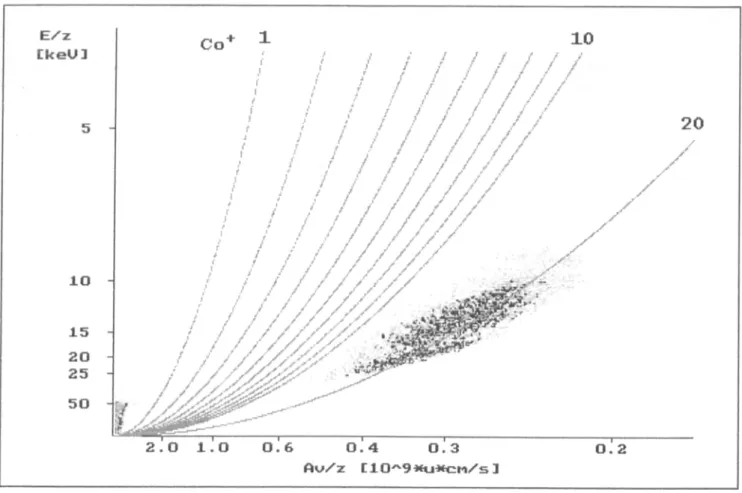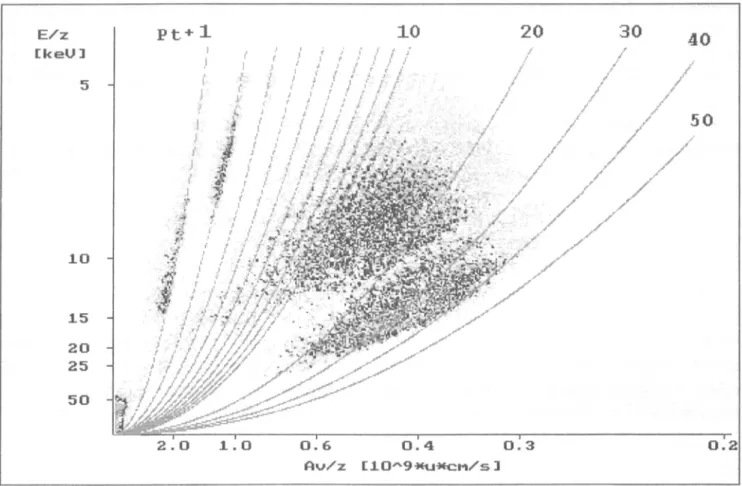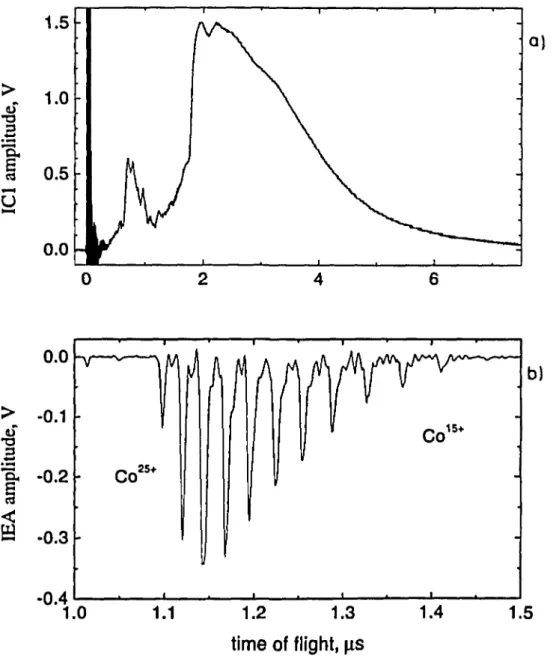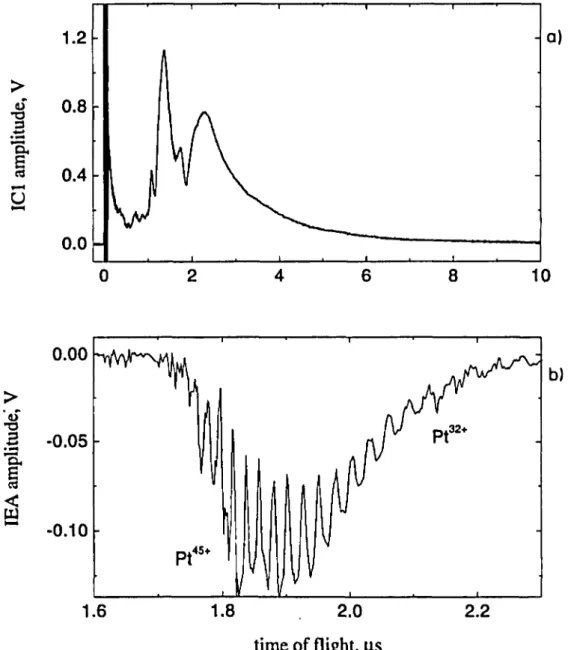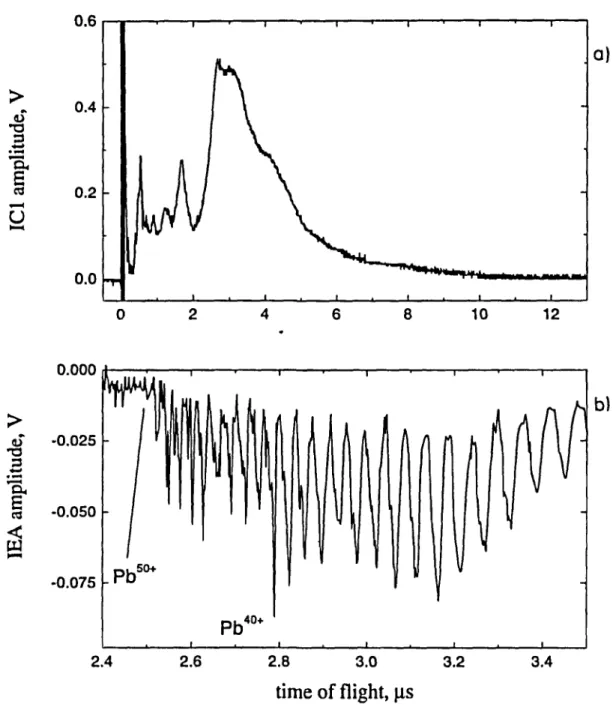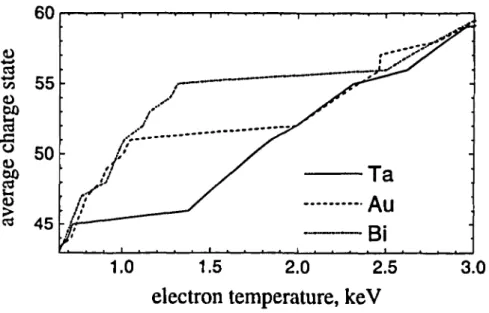Multiply charged ions from iodine laser-produced
plasma of medium- and high-Z targets
BY J. K R A S A , * L. L A S K A , * K. MAI§EK,* M. P F E I F E R , *
B. K R A L I K O V A , * J. S K A L A , * P. S T R A K A , *
K. R O H L E N A , * W. M R O Z , * * E. WORYNA,T P. PARYS,T
J. WOLOWSKI,F H. HASEROTH,T A.A. GOLUBEV,§
AND B.YU. SHARKOV§
•Institute of Physics, AS CR, 180 40 Prague, Czech Republic ••Institute of Optoelectronics, MUT, 01 489 Warsaw, Poland
•{Institute of Plasma Physics and Laser Microfusion, 00 908 Warsaw, Poland JPS-Division, CERN, 1211 Geneva, Switzerland
§Institute of Theoretical and Experimental Physics, 117 259 Moscow, Russia (Received 1 October 1996; Accepted 3 July 1997)
Maximum charge states of ions registered in the far expansion zone from laser-produced plasma of Al, Co, Ni, Cu, Ta, W, Pt, Au, Pb, and Bi are presented. The Thomson parabola spectrometer was used to display a general view of the ion species of an expanding plasma while detailed ion charge-energy spectra were determined by the cylindrical electrostatic ion energy analyzer. The current densities of highly charged ion groups above 20 mA/cm2 were measured by use of an ion collector at a distance of ~ 1 m from the target. The photodissociation iodine laser system PERUN (A = 1.315 /mi, power density up to ~ 1015 W cm"2) was employed as a driver.
1. Introduction
Recent development in laser ion sources (LIS) has made radical improvements in the gen-eration of highly charged ions at current densities of about 0.1-10 mA cm"2 at a considerable distance from the target (Sherwood 1992; L£ska et al. 1994; Baranov et al. 1995; Woryna et al. 1996a; Mr6z et al. 1996a; etc.). This progress also requires upgraded simulations on the emis-sion of highly-stripped fast ions from high-temperature plasma (Te^ 1 keV) and the
recombi-nation processes of ions during plasma expansion to elucidate conservation of their high charge state acquired in the hot plasma core. For the laser plasma ion studies presented up to now, CO2
and Nd:glass lasers were used mainly for interaction with targets of different atomic number Z. Fully stripped ions were detected in case of aluminium (for example, Mr6z et al. 1994). With increasing Z, the production of ions with the highest charge states is more difficult because of the high ionization energy. As for heavy ions, Ta54+ ions were registered by X-ray spectros-copy in the plasma corona (Aglitzkiy et al. 1974); the highest charge state of Ta ions identified by particle diagnostics far from the target was 55+ (Ldska et al 1996).
2. Experimental
This contribution reports that some of our experiments with the laser produced plasma of different elements—Co, Ni, W, Pt, Au, Pb, and Bi—under similar experimental conditions at which the Ta55+ ions were obtained. As a driver, the iodine laser PERUN (Chvojka et al 1992) at Institute of Physics AS CR, Prague was used (A = 1.315 /im, maximum output energy of 50 J,
6 J. Krdsa et al.
350-700 ps pulse duration, conversion to the 2nd and 3rd harmonics about 50%). The laser beam is focused onto the target either with an aspherical f/2 optics (L) or with a parabolic mirror (M); the diameter of the focal spot is about 100 /xm in both cases (the power density ~ 1015 W/cm2). The geometry of the ion measurements was either off the incident laser beam axis using a lens (L) focusing system, or the measurements were coaxial applying a mirror (M). We used the parabolic mirror with a hole in the center to detect ions along the target normal as well as laser beam axis. This configuration makes it possible to extract the highly charged and high energy ions in preference (Woryna et al. 1996b).
The ions were registered by various sensors of particle diagnostics such as 1) a Thomson parabola ion spectrometer (TS) to display a general view of ionization state of expanding plasma and its nature, 2) a cylindrical electrostatic ion energy analyzer (IEA) to determine the distribution of particular ion species, and 3) ion collectors (IC) to estimate the ion current density in a far expansion zone (Denus et al. 1977). The experiments were performed mainly with laser energy of 22-25 J at 350-500 ps pulse length.
The Thomson parabola spectrometer (Woryna et al. 1996b) gives a general view of ion-ization states and energies of ion species in the expanding plasma corona for a single laser shot. The construction of the TS used is based on a configuration with separated electric (E) and magnetic (B) fields. The TS image converter consists of a microchannel plate (MCP), an aluminized luminescent screen, and a Tektronix video camera. The registered parabolas were analyzed starting from comparison with parabolas calculated numerically (Mroz et al. 1996b). Matching the measured parabolas with those computed, both the electric (E) and the magnetic (B) fields may be used as free parameters in calculations because of possi-ble uncertainty in their determination. We have corrected only the magnetic field intensity by this way because the TS d.c. magnet shows residual magnetism after a change of the
E / z CkeUl 5 1 0 15 2O 25 5O
-I
C o * - ; - ~* 2 . 0 l . O 1 i i 1 f j i t 0 . r / / ^ / ii 6 O A w / z / ** r / / ^ i / / / /' •>'* i / / / , . 4 C10^9* / / / »* / / / /" / / / / / / • / ' / / / / / / / / •"* / / / / / / / / / •/ / 0 . 3 tJ«Cli/S 1 10 / / 0 . 2 2 0y
E / z CkeUl 5 1O 15 2O 25 5O -j p t + •j r"
1
. x ^
2 . 0 1 •' i1 /i
1
' - •.' ' . y l . O 10 I1 «* > 1* .'" / / ' 1 !" -" ' j i f j .1 / r! -' ,* / . -0.6 0.4 0 AM/Z C1O~9«u«cn/sJ 20 / / / / /y
. 3 30 / / / /X
40 / 50 / 0 . 2FIGURE 2. Thomson parabola picture of Pt plasma.
5 -E/z CkeUl 1O 15 2O 25 75 -P h 1 f * i » )'*
;ffiF
Ixi;.--^
:
2 . 0 1.0 ! ) f 4 $ i ' / • O . 7 fiu/z 10 • • / / / / / / •*' *;0
:
0.5 0.4 C10~9 «u«cn/s1 20 /' / /' / / , sX y
X"' /X
y X 0 . 3 30 / / / / 40 / 50 /8 J. Krdsa et al.
feeding current. Thus, the correction factor 5 of the magnetic field was taken into a parabola equation
x = yME/z[B(l+8)]2y2,
where x and y are the deflections of ions in the direction parallel to E and perpendicular to B, respectively, y is a geometrical factor and M/z is the ratio of mass to charge state of an ion. The correction factor 8, determined by the parabola matching, ranged from 0.05 to 0.15 in these experiments.
The examples of Thomson parabolas recorded are demonstrated for Co, Pt, and Pb in fig-ures 1-3, respectively. In figure 1, the TS parabolas are not resolved because of insufficient resolution of the imaging system used. But, it is possible to estimate that the charge states of majority of the Co ions range from 15+ to 25+. The parabolas corresponding to Pt ions are shown in figure 2. In contrast to figure 1, there is an overview of all the charge states starting from Pt+. The first 10 ionization states measured (Pt+-Pt10+) were easily identified by match-ing with computed parabolas. Additional computed parabolas make it possible to estimate the highest charge state of ions detected far from the plasma. For example, the position of the computed Pt40+ parabola indicates the appearance of Pt ions carrying charge higher than 40+.
I
U 0.0 0.0 > 4? 3 "a, <B
-0.1 -0.2 -0.3 -0.4 1.0 I - Co2 5' •A
11
f\
I . I . I . b) 1.1 1.2 1.3 1.4 time of flight, usFIGURE 4. IC1 signal (a) and IEA spectrum (b) of Co plasma.
The highest charge state of Pb ions registered by the TS may be estimated to be z ** 47 or 48 (see figure 3).
The promising results from the TS suggest more detail measurements with the IEA. The examples of IC signal and IEA spectra for Co (Ejz - 60 keV), Pt (Ejz = 40 keV), and Pb
(Et/z = 20 keV) are presented in figures 4-6. The ion spectrum for Co ions contains peaks
corresponding to z from 15 to 25, as in the TS image (see figure 1). The highest charge states of Pt and Pb ions were estimated from IEA records as z = 50 and 51, respectively (see figures 5 and 6).
In all the ion collector signals (IC1) presented in figures 4-6, the group of thermal ions dominates; it is localized as latter signal in the time scale. The peaks corresponding to the fast ions may have a multi-peak structure, which can be also seen in the images of Pt and Pb parabolas (figures 2 and 3).
The results obtained are summarized in table 1 together with those obtained previously for Al, Cu (Mr6z W et al. 1994), and Ta (La*ska L et al. 1996), which were received by use of the lens focusing system (L). The ion current density./ measured at a distance of 174 cm from the target, when the parabolic mirror was applied, was recalculated for the path of flight L = 94 cm supposing quadratic decrease of the current density ~L~2 in space. We registered fully stripped Al, or nearly stripped Co and Ni, and ions with charge states higher than 45+ of heavy
ele-1
S a u 0.00 2S 0.05 -a, -0.10 h Pt45 1.8 2.0 2.2time of flight, |i.s
10 J. Krdsa et al. •a 3 "a, a U 0.0 -10 12
I
a, C3 o.ooo 0.025 0.050 0.075 -2.6 2.8 3.0 3.2 3.4 time of flight, usFIGURE 6. IC1 signal (a) and IEA spectrum (b) of Pb plasma.
ments such as Ta, W, Pt, Au, Pb, and Bi. It is worth mentioning that mostly the ions with ionization energy below 4 keV were produced in our experimental conditions, with the
excep-tion of Ta because the ionizaexcep-tion energy needed to produce Ta5 4 + is about 5 keV.
3. Discussion
In the process of laser-plasma interaction, electron density, electron temperature, and inter-action time are the parameters which control the ionization state of plasma. The temperature of
TABLE 1. Summarized results of highly charged ion production
Element Zmax E/,max.MeV <Zfast> (£,-fast>,MeV y, mA/cm2 Ilium, system Al 13 0.35 L Co 25 2.6 22 1.9 14.2 M Ni 26 2.5 20 0.92 18.5 M Cu 25 L Ta 55 8.8 12.8 L Ta 48 7.7 42 2.3 22.8 M W 49 4.9 45 2.0 22.8 M Pt 50 8.5 40 3.1 12.8 M Au 49 4.8 38 3.1 7.0 M Pb 51 5.1 40 3.3 8.5 M Bi 51 5.1 40 2.7 10.0 M
1.0 1.5 2.0 2.5
electron temperature, keV
FIGURE 7. Average charge state of Ta, Au and Bi ions versus electron temperature.
the plasma, as well as the ion energy, depend on laser power density (Gitomer et al. 1986). The higher power density focused on a target results in a temperature exceeding 1 keV. During the expansion of plasma, the electron temperature is falling fast because in this case as well, the laser power decreases quickly. The temperature is decreasing when the ions are still passing through a comparatively dense region. Owing to the temperature drop, recombination sets in. The high-charge states will thus be destroyed before the system is out of thermodynamic equilibrium and the high-charge states have been "frozen in." Especially vulnerable are the high z ions. This scenario applies to the thermal ion group, which follows the fast group and carries charge states, which are generally lower.
Using the formula for the dependence of the electron temperature, Te, on the laser power,
average charge state of ions (zo) in the focal spot and the focal diameter, based on the energy balance of laser absorbed energy and the electron conductivity flux from heated plasma zone (Roudskoy 1993), the Te> 1.5 keV with (z0) — 40 can be estimated for our experimental
conditions. Another possibility for estimating the electron temperature is given by a mixed model of Busquet (1982). Using it, we obtained the temperature re~ 1.7 keV and the average
charge state (z0) ~ 50 for Ta from experimentally given ion energy. This model makes it
possible to calculate a dependence of average charge state on electron temperature (see fig-ure 7).
Explanation of the occurrence of the highly charged ions in a far expansion zone may be based on the presence of the fast and thermal ion groups. Their existence means that the plasma time evolution follows the mechanism of two-temperature isothermal expansion (Wickens & Allen 1979). Primarily, a hot electron group with temperature higher than that of the thermal group is formed by a collisionless absorption near the critical surface. Escaping from the plasma, the hot electrons generate an electric field which accelerates the ions pulled behind the electrons. The ions with high charge states are guided through the dangerous recombination zone by these hot electrons. This enhances the phenomenon of charge state "freezing," and the ions, originally present in corona, survive.
Acknowledgment
This work was performed in a partial fulfillment of research grant project No. A1010525 sponsored by the Academy of Sciences of the Czech Republic, grant project No. 202/95/ 0039 sponsored by the Grant Agency of the Czech Republic, and grant project No. 657/55/ 94/07 sponsored by the State Committee for Scientific Research of Poland.
12 J.Krdsaetal. REFERENCES
AGLITZKIV E.V. et al. 1974 Kvantovaya Elektronika 1, 2067.
BARANOV V.YU. et al. 1995 Troitsk Institute for Innovative and Thermonuclear Investigations Report
0015-A, Troitsk, Russia.
BUSQUET, M. 1982 Phys. Rev. B25, 2302.
CHVOJKA, M. etal 1992 Czech. J. Phys. 42, 899. DENUS, S. et al. \911 J. Tech. Phys. 18, 25. GITOMER, S.J. et al. 1986 Phys. Fluids 29, 2679. LASKA L. et al. 1994 Appl. Phys. Lett. 65, 691.
LASKA, L. etal. 1996 Rev. Sci. Instrum. 67, 950. MR6Z, W. etal. 1994Rev. Sci. Instrum. 65, 1272.
MR6Z, W. et al. 1996a Fusion Engineering and Design 32,425. MR6Z, W. et al. 1996b Rev. Sci. Instrum. 67, 1272.
ROUDSKOY, I.V. 1993 PhD Thesis, ITEP Moscow.
SHERWOOD, T.R. 1992 Rev. Sci. Instrum. 63, 2789.
WICKENS, L.M. & ALLEN, IE. 1979 J. Plasma Physics 22, 167. WORYNA, E. etal. 1996aAppl. Phys. Lett. 69, 1547.
